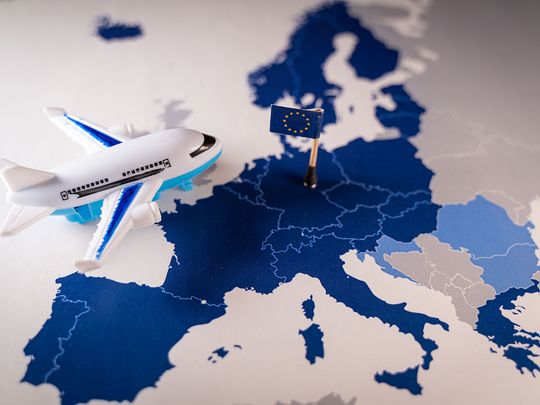Dubai: Say goodbye to long queues and passport stamps! Later this year, the European Union (EU) will introduce the Entry/Exit System (EES), a digital system that streamlines border control for non-EU travellers. Announced by the EU, the system is expected to come into effect in the second half of 2024.
Here’s everything you need to know about this exciting change.
What is the Entry/Exit System (EES)?
The EES is an automated system that will save time for travellers by eliminating passport stamping and automating border control procedures.
When you go through the system, you will have to provide your passport, a photo of your face will be taken, and your fingerprint will be scanned.
To be able to use the system, you need to ensure that you have a biometric passport (a passport containing a chip with your biometric information collected from you at the moment you applied for the passport). You will also be required to provide your biometric data, like your fingerprint for scanning. Refusal to provide this data will result in entry being denied into the territory of European countries using EES.
What data does EES store?
• Records of your entry and exit within the Schengen zone.
• Personal data – nationality, full name and date of birth
• Biometric data
• Any refusals of entry.
Who can use EES?
• Those who possess a Schengen short-stay visa
• Those who don’t require a visa (staying up to 90 days in any 180 days) and are travelling with a European Travel Information and Authorisation System (ETIAS) waiver.
Remember: This applies across all Schengen Zone countries using EES.
What is a short stay visa?
Source: home-affairs.ec.europa.eu
European countries using the EES
The EES is rolling out across most EU member states, with the exception of Cyprus and Ireland, where passports are still stamped manually.
1. Austria
2. Belgium
3. Bulgaria
4. Croatia
5. Czechia (Czech Republic)
6. Denmark
7. Estonia
8. Finland
9. France
10. Germany
11. Greece
12. Hungary
13. Iceland
14. Italy
15. Latvia
16. Liechtenstein
17. Lithuania
18. Luxembourg
19. Malta
20. Netherlands
21. Norway
22. Poland
23. Portugal
24. Romania
25. Slovakia
26. Slovenia
27. Spain
28. Sweden
29. Switzerland
What is Schengen Visa?
A Schengen visa is an entry permit for non-EU nationals to make a short, temporary visit of up to 90 days in any 180-day period to a country in the Schengen area.
Schengen visas come in three forms:
• single-entry visa – allowing you to enter the Schengen area once;
• multiple-entry visa – allowing several visits to the Schengen area for as long as the visa is valid;
• airport transit visa – allows you to connect through the international transit area of an airport in the Schengen area during a stopover or a change of flights. It does not allow you to leave the international transit area.

